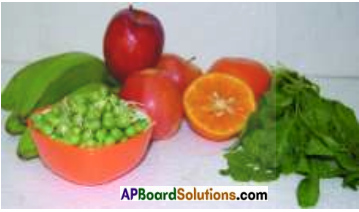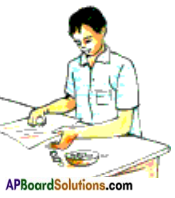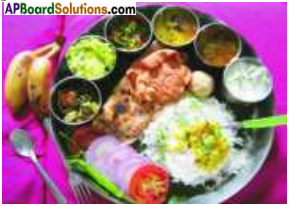These AP 7th Class Science Important Questions 1st Lesson Food Components will help students prepare well for the exams.
AP State Syllabus 7th Class Physical Science 1st Lesson Important Questions and Answers Food Components
7th Class Science 1st Lesson Food Components Important Questions and Answers
Question 1.
What type of food is required to keep us healthy?
Answer:
- Generally every food item contains all the components of food.
- But some components may be more while some may be less.
- We require different quantities of carbohydrates, proteins and fats according to age and need of individuals.
- Growing children and adolescents need more protein-containing food like milk, meat, pulses etc.
- We also need minute quantities of some other components called vitamins and minerals to keep us healthy.
![]()
Question 2.
What are roughages? In what way are they useful to us?
Answer:
- There are some components of food that are necessary for our body called roughages or dietary fibres.
- Vegetables like a ribbed gourd, bunch beans, lady’s finger or some boiled sweet potato etc. are called roughages.
- Roughages are a kind of carbohydrate that our body fails to digest.
- They help in free bowel movement in the digestive tract and prevent constipation.
Question 3.
Mention some sources of roughages.
Answer:
Sources of Roughages:
- Bran, shredded wheat, cereals, fruits and vegetables, sweet and plain potato, peas and berries, pumpkins, palak, apples, banana, papaya and many kinds of beans are the sources of roughages.
- We must take care to include sufficient fibre foods in our daily diet.
Question 4.
Why should we eat fruits with peels? What should be done before eating them.
Answer:
- Generally we have a habit of eating some fruits without peels.
- We eat banana without peel but fruits like apples, grapes, sapota are eaten along with peels.
- Most of the vegetable are also used along with peels, sometimes we make some special dishes like chutneys etc., with peels.
- So don’t peel or discard outer layers of fruits or vegetables.
- They are rich in nutrients.


- Peel contains fibre which helps in digestion.
- But now a days farmers use many pesticides in the fields.
- They are very dangerous for our health so we must wash fruits and vegetables with salt water thoroughly.
- Then only it becomes safe to eat them along with peels.
![]()
Question 5.
Do fruits and vegetables contain water in them? Give some examples of such fruits.
Answer:
- Water is also an essential component needed by our body.
- We should drink sufficient water for our body.
- We get water from fruits and vegetables also.

- Most fruits and vegetables contain water.
- Cut these fruits and vegetables. We find water in them.
- Most vegetables like potatoes, beans, kheera, tomatoes, gourds and fruits like apples, papaya and melons etc., contain water.
Question 6.
Why does our body need water? Explain with an example.
Answer:
- Take a piece of sponge and try to move it in a pipe.
- It moves with some difficulty. Remove the sponge from the pipe, dip it in water and try to move it again in the pipe.

- It moves freely or smoothly.
- Water is food and it also helps the food to move easily in the digestive tract.
- Water helps in many other processes in our body as well.
- Hence, we must drink plenty of water.
Question 7.
How would you make your diet a balanced one?
Answer:
- Taking green salads and vegetables everyday.
- Taking foods like cereals, pulses, milk etc., adequately.
- Taking a bit of fat (Oil, Ghee, Butter etc.)
- Don’t forget to supplement your daily diet with green salads and vegetables.
![]()
Question 8.
Write the history of food and nutrition.
Answer:
History of food and nutrition:
- Until about 170 years ago there was little scientific knowledge in the West about nutrition.
- The founder of modern science of nutrition was Frenchman named Lavoisier (1743 to 1793) whose contribution paved new ways to nutrition research.

- In the year 1752 James Lind’s discovered “Scurvy” which could be cured or prevented by eating fresh fruits and vegetables.
- It was known that diseases could be cured by eating certain kinds of foods.
- In 19th century it was known that the body obtains food from three substances namely proteins, fats and carbohydrates.
Question 9.
How do you test the presence of starch in the food item given to you.
Answer:
Test for Starch: N – line Preparation of dilute iodine solution
- Take a test tube or a cup and add few drops of Iodine solution to it.
- Then dilute it with water till it becomes light yellow / brown in colour.

- Take a sample of food item in the test tube.
- Add a few drops of dilute Iodine solution on the sample we have collected.
- Observe the change in colour.
- If the substance turns dark-blue or black, it contains starch.
Question 10.
Describe how do you test the presence of fats in the food item given to you.
Answer:
Test for fats:
- Take a small quantity of each sample.

- Rub it gently on a piece of paper.
- If the paper turns translucent the substance contains fats.
![]()
Question 11.
What test do you conduct to detect the presence of proteins in the food item given to you?
Answer:
A) Preparation of solutions:
- Preparation of 2% copper sulphate solution: To make 2% copper sulphate solution dissolve 2 gms of copper sulphate in 100 ml. of water.
- To make 10% of sodium hydroxide solution: Dissolve 10 gms of sodium hydroxide in 100 ml. of water.
B) Test for proteins:
- If the substance to test is a solid, grind it into powder or paste.
- Add a little of it in the test tube and add 10 drops of water to the powder and stir well.
- Add 10 drops of this solution in a clean test tube. Add 2 drops of copper sulphate solution and 10 drops of sodium hydroxide solution to the test tube and shake well.
- Change of colour to violet or purple confirms presence of protein.
Question 12.
What do the above tests confirm?
Answer:
- The above tests show the presence of components of food which are usually present in larger amounts as compared to others,
- All types of food that we eat contain all the above-mentioned food components.
- The quantity of each component varies from type to type.
Question 13.
Collect some food packets like chips, coffee, milk, juice … etc., and put a tick mark if you find the listed food components present in food items.
Answer:
Table: Food items and components

![]()
Question 14.
What are the components found in biscuits?
Answer:
In biscuits the following components are present.
- carbohydrates
- proteins
- fat
- sugars
- saturated fatty acids
- mono unsaturated fatty acids
- poly unsaturated fatty acids
- trans-fatty acids
- cholesterol
- calcium
- iron
- iodine
- vitamins.
Question 15.
What components are most common in your list?
Answer:
The common components in the list are
- carbohydrates
- proteins
- fats
- sugars
- minerals and
- vitamins.
Question 16.
Do you find any vitamins and minerals in the biscuits? What are they?
Answer:
- I find vitamins and minerals in the biscuits.
- They are
a) Vitamin – D, Vitamins B, B6 and B12 - a) Calcium, b) Iron, c) Iodine are the minerals present.
![]()
Question 17.
Where do you write salt and sugar? Why?
Answer:
- Salt and sugar are written separately.
- These two components are not present in all the food items as common.
Question 18.
Are there any food items with similar components?
Answer:
Many ready made food items packed will have similar components.
Question 19.
What are the essential components of food?
Answer:
- Our food consists of carbohydrates, proteins, fats, vitamins and minerals.
- Besides these, water and fibres are also present.
Question 20.
Different food items are given in the table below. Find out the type of components in them and fill the information on the basis of your observations.
Answer:
Table: Testing of food items for carbohydrates, proteins, fats

Question 21.
Which foods show the presence of starch?
Answer:
- Rice (78.2%)
- Potato (22.6%)
- Milk (5%)
- Curd (3%)
- Egg (0%)
![]()
Question 22.
What nutrients are present in milk?
Answer:
In buffalo’s milk
- Minerals are present (0.8%)
- Calcium (210 mg per 100 g) is present
- Phosphorus (130 mg per 100 g) is present
- Iron (0.2 mg per 100 g) is present.
Question 23.
Which components of food could you identify in potatoes?
Answer:
The following components are identified in potatoes.
a) (1.6 gm per 100 gm) proteins.
b) (0.1 gm per 100 gm) fat
c) (0.6 gm per 100 gm) minerals
d) (0.4 gm per 100 gm) fibre
e) (22.6 gm per 100 gm) carbohydrates
f) (10 mg per 100 gm) calcium
g) (40 mg per 100 gm) phosphorus
h) (0.48 mg per 100 gm) iron
Question 24.
Which food item contain more fat?
Answer:
Buffalo’s milk contains more fat (6.5 gm / 100 gm)
Question 25.
Which food items contain more protein?
Answer:
a) Rice contains proteins of 6.8 gm / 100 gm
b) Potato contains proteins of 1.6 gm / 100 gm.
c) Milk contains proteins of 4.3 gm / 100 gm
d) Curd contains proteins of 3.1 gm / 100 gm.
e) Egg contains proteins of 13.3 gm / 100 gm.
So egg and milk contain more proteins compared to other food items.
Question 26.
Why should we eat food?
Answer:
We should eat food because food supplies the energy we need to do many tasks in our day to day activities.
![]()
Question 27.
Do we need energy while sleeping?
Answer:
- While we are sleeping, we breathe.
- The circulation of blood in our body goes on.
- So we need energy while we are sleeping.
Question 28.
Suppose you do not get food for lunch how do you feel?
Answer:
- If I do not get food for lunch, I shall be very much tired and exhausted with lack of supply of energy at the end of the day.
- I shall feel very weak. The hunger will be in an alarming condition.
- I shall be ready to eat anything that is available.
Question 29.
If you do not get food for many days what will happen to you?
Answer:
- If I do not get food for many days, I shall become very weak and the resistive power of my body decreases very much.
- The energy resources in my body will also be exhausted.
- There will be a danger to my life.
Question 30.
Mention some food items which keep you healthy.
Answer:
Dry fruits like dates, plums, raisins, cashew nuts, pistachios, etc., also keep us healthy.
Question 31.
Is balanced diet cheap? Explain.
Answer:
- Scientists have found out that a balanced diet need not necessarily be costly.
- Everyone can afford it, even the poor.
- If a person eats dal, rice, rotis, green vegetables, little oil and jaggery all the food requirements of the body are fulfilled.
- Just balancing our diet with different kinds of foods is not enough.
- It should be cooked in a proper way.
![]()
Question 32.
List the food items eaten by you yesterday from breakfast to dinner.
a) Does your diet contain all necessary components of food in it.
Answer:
Following is the list of the food items eaten by me yesterday.

a) Yes, my food contains all necessary components of food.
Question 33.
Look at the food ‘THAU’ with many food items and list out the food items and food components in it. You need not eat all items as shown in the “THAU” rather you should ensure that your food contains all food components everyday in adequate quantity. For example, a diet containing food items having more of carbohydrates and protein along with a little fat, vitamins and minerals makes a balanced diet.

Answer:
| Food Items | Food Components |
| Rice | Carbohydrates |
| Red gram dal | Proteins |
| Chapathi | Carbohydrates |
| Vegetable curry | Fats, vitamins, minerals |
| Banana | Minerals |
| Green salad | Vitamins & minerals |
| Curd | Fat, minerals |
Question 34.
How and why the nutrients in the food are lost?
Answer:
You know many nutrients are lost by over cooking, re-heating many times, washing the vegetables after cutting them into small pieces.
Question 35.
Write which foods are to be eaten moderately, adequately, plenty and sparingly.
Answer:
- Foods like cereals, pulses, milk etc. should be taken adequately.
- Fruits, leafy vegetables and other vegetables should be used in plenty.
- Cooking oils and animal foods should be used moderately.
- Vanaspathi, Ghee, Butter, Cheese must be used sparingly.
![]()
Question 36.
Why should we avoid Junk foods?
Answer:
- If we are eating only pizzas and sandwiches daily.

- Our body is being deprived of other food substances.
- Junk food causes damages to our digestive system.
- It is better to avoid eating junk food.
Question 37.
On what factors do the food habits of people depend?
Answer:
- Food habits of the people depend upon climatic conditions and cultural practices of the particular place.
- We eat rice in large quantities but people living in north India eat chapathies as daily food.
- Because wheat is grown widely in that region.
- The way of cooking and eating food also reflects the cultural practices of people.
Question 38.
Kiran wants to know about nutrients in the milk. He added 2 drops of Copper Sulphate solution and 10 drops of Sodium Hydroxide solution to the Milk. What colour he may have observed in it? Which nutrient does he find in the milk?
Answer:
- Take 10 drops of milk in a clean test tube.
- Add 2 drops of Copper Sulphate solution and 10 drops of Sodium Hydroxide solution to the test tube and shake well.
- We observe the change of colour to violet or purple.
- The colour confirms presence of proteins in milk.
Question 39.
Who need the highest proportion of Proteins in their daily diet-a 15 year old boy, a 55 year old female writer and 35 year old male bank officer? Explain why.
Answer:
- The boy with an age of 15, requires high quantity of proteins in his diet.
- Because proteins are very essential for his physical growth.
- The boy is in adolescence, hence he has rapid physical growth. So, he needs high quantity of proteins in his diet.
![]()
Question 40.
We are suffering from various gastro intestinal diseases. What precautions do you take to avoid these diseases?
Answer:
- We should take healthy nutritious diet.
- We should consume high fibre content food like leafy vegetables. They have roughages. They are very helpful in preventing constipation.
- Avoid junk foods completely.
- We should cultivate healthy food habits.
Question 41.
You did an experiment in your classroom to test the proteins. In that
i) What apparatus did you use in that experiment?
ii) What are the solutions you prepared?
iii) What change did you observe in the colour?
iv) What precautions did you take in this experiment?
Answer:
a) Test tubes, Dropper.
b) 2% Copper Sulphate solution and 10% Sodium Hydroxide solution.
c) Violet or purple colour.
d) Take care of measuring chemicals while preparing the solutions.
Question 42.
What are the major nutrients found in our food?
Answer:
There are three major nutrients present in our body. They are: 1) Carbohydrates, 2) Proteins and 3) Fats.
![]()
Question 43.
Define the term balanced diet. Which food items are to be eaten moderately, ade¬quately, plenty and sparingly to make our diet a balanced one?
Answer:
- The diet that is with all the required nutrients in adequate quantities is called balanced diet.
- Energy is required according to the age and nature of work.
- Carbohydrates provide energy and are present in cereals, pulses, milk etc. They should be taken adequately.
- Vitamins, minerals available in vegetables, fruits and leafy vegetables should be used in plenty.
- Fats present in cooking oils and animal foods should be used moderately.
- Vanaspati, ghee, butter and cheese must be used sparingly.
Question 44.
Madhavi eats only biryani and chicken daily. Do you think it is a balanced diet? Why? If not, write a few suggestions to make her diet a balanced diet.
Answer:
- Madhavi’s diet is not a balanced diet.
- We should take a balanced diet containing all the nutrients.
- Madhavi can get only carbohydrates, proteins and fats in large quantities through her meal.
- This diet leads to obesity in future.
- Madhavi should take fruits, vegetables, in order to get vitamins and minerals as well as roughages.
Question 45.
How do you test the presence of starch in the food item given to you? (OR) Write the procedure of test for carbohydrates conducted in your classroom.
Answer:
Test for Starch: N – line Preparation of dilute iodine solution
- Take a test tube or a cup and add few drops of Iodine solution to it.
- Then dilute it with water till it becomes light yellow/brown in colour.

- Take a sample of food item in the test tube.
- Add a few drops of dilute Iodine solution on the sample we have collected.
- Observe the change in colour.
- If the substance turns dark-blue or black, it contains starch.
